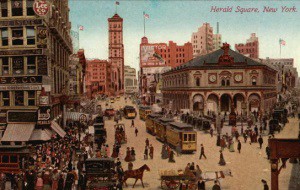Horny Visitor Cannot Mate With Locals

Like all visitors, it crawls about the High Line, being annoying. Yet this one cannot make sex with New York residents. Please welcome Periplaneta japonica, the cold-resistant cockroach.
Rich People Looking At Art
by Ali Pechman

While the herds fight over art and VIP access down at Art Basel Miami Beach, a reminder that some things never change.
This was it, the start of the Biennale proper: the onset of party-anxiety and invite-envy, the fear that there were better parties you’d not been invited to, a higher tier of pleasure that was forbidden to you…You could be at a tremendous party, full of fun people, surrounded by beautiful women, booze flowing, totally happy– but part of you would be in a state of torment because there was another party to which you’d not been invited. There was nothing to do about it.
–Geoff Dyer, Jeff in Venice, Death in Varanasi
During the time I had spent in Miami many people had mentioned, always as something extraordinary, something I should have seen if I wanted to understand Miami, the Surrounded Islands project executed in Biscayne Bay in 1983 by the Bulgarian artist Christo. Surrounded Islands…had been mentioned both by people who were knowledgeable about conceptual art and by people who had not before heard and then could not then recall the name of the man who had surrounded the islands. All had agreed. It seemed that the pink had shimmered in the water…. It seemed that this period when the pink was in the water had for many people exactly defined, as the backlit islands and fluorescent water and the voices at the table were that night defining for me, Miami.
-Joan Didion, Miami
Sherman now noticed, over the bed, a small painting with a simple frame of blond wood. He took a couple of steps closer. It was a picture of a nude man, seen from the rear, outlined in crude black brushstrokes, the way an eight-year-old might do it, assuming an eight-year-old had a notion to paint a nude man…. What a piece of garbage… It was sick … But it gave off the sanctified odor of serious art, and so Sherman hesitated being candid.
“Where’d you get that?”
“You like it? You know his work?”
“Whose work?”
“Filippo Chirazzi.”
“No, I don’t know his work.”
She was smiling. “There was a whole article about him, in the Times.”
–Tom Wolfe, Bonfire of the Vanities
This personage wandered back to the divan and seated himself, on the other side, in view of the great canvas on which Paul Veronese has spread, to swarm and glow there forever, the marriage-feast of Cana of Galilee. Weary as he was his spirit went out to the picture; it had an allusion for him; it satisfied his conception, which was strenuous, of what a splendid banquet should…Suddenly he was aware of the prime throb of the mania of the “collector.” He had taken the first step — why should he not go on? It was only twenty minutes before that he had bought the first picture of his life, and now he was already thinking of art-patronage as a pursuit that might float even so heavy a weight as himself.”
–Henry James, The American
The Welly Brys, after much debate, and anxious counsel with their newly acquired friends, had decided on the bold move of giving a general entertainment. To attack society collectively, when one’s means of approach are limited to a few acquaintances, is like advancing into a strange country with an insufficient number of scouts; but such rash tactics have sometimes led to brilliant victories, and the Brys had determined to put their fate to the touch. Mrs. Fisher, to whom they had entrusted the conduct of the affair, had decided that TABLEAUX VIVANTS and expensive music were the two baits most likely to attract the desired prey, and after prolonged negotiations, and the kind of wire-pulling in which she was known to excel, she had induced a dozen fashionable women to exhibit themselves in a series of pictures which, by a farther miracle of persuasion, the distinguished portrait painter, Paul Morpeth, had been prevailed upon to organize. Lily was in her element on such occasions. Under Morpeth’s guidance her vivid plastic sense, hitherto nurtured on no higher food than dress-making and upholstery, found eager expression in the disposal of draperies, the study of attitudes, the shifting of lights and shadows. Her dramatic instinct was roused by the choice of subjects, and the gorgeous reproductions of historic dress stirred an imagination which only visual impressions could reach. But keenest of all was the exhilaration of displaying her own beauty under a new aspect: of showing that her loveliness was no mere fixed quality, but an element shaping all emotions to fresh forms of grace.
— Edith Wharton, House of Mirth
Every part of the great building was given over to the festivities. There was dancing in every room and in the basement as well. Corridors and stairs were filled to overflowing with masks and dancing and music and laughter and tumult…The walls were mostly hung with wild and cheerful paintings by the latest artists. All the world was there, artists, journalists, professors, business men, and of course every adherent of pleasure in the town…. Pushed hither and thither in the crowd I found myself in one room after another, upstairs here and downstairs there. A corridor in the basement had been staged as hell by the artists and there a band of devils played furiously…. By midnight I had found no one, and though I had not danced I was hot and giddy. I threw myself into the nearest chair among utter strangers and ordered some wine, and came to the conclusion that joining in such rowdy festivals was no part for an old man like me.
–Hermann Hesse, Steppenwolf
Right at the end of his life, [my father] suddenly, without realizing it, found himself in the fashion. The first sign of this was in 1935, when his Agag before Samuel was bought at a provincial exhibition for 750 guineas…. The purchaser of this work was Sir Lionel Sterne. ‘Honest Sir Lionel,’ said my father, as he saw the great canvas packed off to Kensington Palace Gardens, ‘I should dearly have liked to shake his hairy paw. I can see him well — a fine, meaty fellow with a great gold watch-chain across his belly, who’s been decently employed boiling soup or smelting copper all his life…. In every age it had been men like him who kept painting alive.’ I tried to explain that Lionel Sterne was the youthful and elegant millionaire who for ten years had been a leader of aesthetic fashion. “Nonsense!” said my father…”Only Phillistines like my work and, by God, I like only Phillistines!
–Evelyn Waugh, Work Suspended
What he saw, meanwhile, with the help of the lamp, was the faded shadowy charm of a room unlike any room he had known. He knew that the Countess Olenska had brought some of her possessions with her — bits of wreckage, she called them — and these, he supposed, were represented by some small slender tables of dark wood, a delicate little Greek bronze on the chimney-piece, and a stretch of red damask nailed on the discoloured wallpaper behind a couple of Italian-looking pictures in old frames.
Newland Archer prided himself on his knowledge of Italian art. His boyhood had been saturated with Ruskin, and he had read all the latest books: John Addington Symonds, Vernon Lee’s “Euphorion,” the essays of P. G. Hamerton, and a wonderful new volume called “The Renaissance” by Walter Pater. He talked easily of Botticelli, and spoke of Fra Angelico with a faint condescension. But these pictures bewildered him, for they were like nothing that he was accustomed to look at (and therefore able to see) when he travelled in Italy; and perhaps, also, his powers of observation were impaired by the oddness of finding himself in this strange empty house, where apparently no one expected him.
— Edith Wharton, Age of Innocence
As when he was young, [Vronsky] showed some inclinations toward art, and, not knowing what to do with his money, had begun to collect engravings, he had tried his hand at painting. And now he took it up again and employed in it that unexpended superfluity of energy which demanded employment. He had the capacity for appreciating art, and he thought that this was all that an artist needed…He understood all kinds, and could get inspiration from art; but he could not imagine that it was possible to be entirely ignorant of the various styles of art and to draw inspiration directly from what is in the soul itself, not caring what may be the result or to what famous school it may belong. As he did not know this, and drew his inspiration, not directly from life, but from life as expressed in art, so he became easily and speedily inspired, and with equal ease and rapidity succeeded in making what he undertook to paint a very good resemblance that style he was trying to imitate.
–Leo Tolstoy, Anna Karenina
Two hundred or so restless souls, most of them middle-aged men, 11 of whom had been pointed out to Magdalena as billionaires — billionaires — 12, if you counted Maurice himself, were squirming like maggots over the prospect of what lay on the other side of an inch-thick glass wall just inside a small portal, Entrance D of the Miami Beach Convention Center. The Convention Center took up an entire city block on Miami Beach. An ordinary person could walk past Entrance D every day for years and never be conscious of its existence. That was the whole point. Ordinary people didn’t know and mustn’t know that billionaires and countless nine-digit millionaires were in there squirming like maggots… 15 minutes before Miami Art Basel’s moment of money and male combat. They all had an urge.
The maggots!
–Tom Wolfe, Back to Blood
Our young man had not in any recent year failed to see the Salon, which the general voice this season pronounced not particularly good….The precinct of the marbles and bronzes spoke to him especially to-day; the glazed garden, not florally rich, with its new productions alternating with perfunctory plants and its queer, damp smell, partly the odour of plastic clay, of the studios of sculptors, put forth the voice of old associations, of other visits, of companionships now ended — an insinuating eloquence which was at the same time somehow identical with the general sharp contagion of Paris. There was youth in the air, and a multitudinous newness, for ever reviving, and the diffusion of a hundred talents, ingenuities, experiments… the white images, hard in their crudity, spotted the place with provocations; the rattle of plates at the restaurant sounded sociable in the distance, and our young man congratulated himself more than ever that he had not missed his chance.
–Henry James, The Tragic Muse
After pushing forward some contemporary masters in the early portions of their career, the picture-dealer, a man of progressive ideas, had tried, while clinging to his artistic ways, to extend his pecuniary profits. His object was to emancipate the fine arts, to get the sublime at a cheap rate,… With his mania for pandering to public opinion, he made clever artists swerve from their true path, corrupted the strong, exhausted the weak, and got distinction for those of mediocre talent; he set them up with the assistance of his connections and of his magazine….To those who complained that he had taken an advantage of them, he would reply by a slap on the stomach. Generous in other ways, he squandered money on cigars for his acquaintances, “thee’d” and “thou’d” persons who were unknown, displayed enthusiasm about a work or a man; and, after that, sticking to his opinion, and, regardless of consequences, spared no expense in journeys, correspondence, and advertising.
Gustave Flaubert, A Sentimental Education
Ali Pechman is a writer living in New York City. She has written about art for Artforum, Artnews, and the Paris Review Daily. Photo of work by Meschac Gaba by Didier Leroi.
New York City, December 5, 2013

★★ The fog closed in from the sides: from Amsterdam, Broadway seemed to be missing, and from Riverside Boulevard there was no visible river. When it finally lifted, the clouds and dampness stayed. A group of tourists, speaking Chinese, held up a shopping bag to ask where to find Uniqlo. The humidity chilled the skin, but the chill sank in no deeper than that. In the night, down below Rector Street, a ship’s horn reverberated. Neon lettering bled color onto the thick air. The fog was returning, this time from above, the building tops dematerializing into the blur of their own lights.
Written In The $tars
“Financial astrologers believe the position of the planets can make a share price plummet. Why do many traders trust them?”
Nashville Couple Expelled From Mall For Festive Dress No More Freakish And Depressing Than Anyone...
Nashville Couple Expelled From Mall For Festive Dress No More Freakish And Depressing Than Anyone Else In Tennessee
“Wore Costume”
The Squares Of New York City, In Order

17. Stuyvesant
16. Times
15. Herald
14. Mitchel
13. Lincoln
12. Montefiore
11. Verdi
10. Lafayette
9. Cooper
8. Tompkins
7. Madison
6. Hanover
5. Chatham
4. Abingdon
3. Jackson
2. Union
1. Washington
'Mood Sweater' Reveals Wearer's Feelings, Such As "Utter Disregard For What Other People Think Of...
‘Mood Sweater’ Reveals Wearer’s Feelings, Such As “Utter Disregard For What Other People Think Of My Appearance”
“If you’ve ever wondered how someone is truly feeling, maybe you can convince her to don this mood-changing sweater. Embedded with sensors, the GER Mood Sweater has lights around the collar that change with the wearer’s emotions.”
The Facts About The Doritos® Locos Taco -- And About An American Hero
by Adam Chandler

With any luck, when the origin myth of the Doritos® Locos Taco is whispered to schoolchildren generations from now, they will know the name Todd Mills. He was an Air Force vet, a former Bill Clinton escort (y’know, the good kind), a father of two, and one among possibly thousands of Americans who dreamed drooly dreams about the marriage between two American icons of chemical gastronomy.
The only difference is that Mills — who passed away on Thanksgiving morning at age 41 — did something about it. In recent days, he’s been hailed as a dreamer and a crusader — but what you’ve heard is only half the story.
The saga starts four years ago when Mills wrote a letter to Frito-Lay, the parent company of Doritos, and begged them to consider making a nacho cheese taco shell. (“I know… It’s an amazing thing to ponder,” he scribbled.) What ensued was a heroic tale of fortitude, decency, and tragedy, something of an era long bygone.
After Frito-Lay snubbed him, Mills launched a Facebook page in 2009 called the “Taco Shells made from Doritos Movement.” And with it, a revolution. He Photoshopped renderings of a Doritos shell framed before an adoring crowd at the Louvre; making demands at an Occupy protest; powering Dr. Emmett Brown’s time-traveling DeLorean. Thousands liked the page, the page went viral, and Taco Bell even began commenting on his postings. The Doritos Locos Taco would soon become a reality.

To honor his tireless advocacy, Mills would be flown out to Taco Bell headquarters in Irvine, California. They fed him a steak dinner, introduced Mills to the CEO of Taco Bell, and gave him a sample of the new Doritos Locos Taco from the test kitchen. Shortly after the product finally launched in March 2012, Mills posted an image of a Doritos Locos Taco shell at a podium on the deck of the USS Abraham Lincoln aircraft carrier beneath the banner that read Mission Accomplished. It had been.
Fast forward to December 2013. Over 600 million Doritos Locos Tacos sold. Over a billion dollars in taco sales netted. 15,000 jobs created, give or take some math. The Doritos Locos Taco is so popular, the shell has been reversed engineered to be sold in chip form by Frito-Lay.

As news of Mills’ passing cascaded across the internet, he was bestowed with honorifics like mastermind, creator, visionary, and inventor of the Doritos Locos Taco.
But this wasn’t the first challenge to the Taco Bell authorship narrative.
Back in May, a guy named Gary Cole (a federal inmate, not the smarmy boss from Office Space) reportedly tried to sue from his super-max prison cell in Florence, Colorado, claiming that he had written his idea for the Doritos Locos Taco shell in a letter that had been stolen by the postal service and sold to Taco Bell and Frito-Lay. (“Get in line,” said every person who’s ever been stoned.) Unsurprisingly, the story didn’t get far.
This week, a chorus is suggesting that Todd Mills had inhabited the unsung role of Antonio Meucci to Alexander Graham (Taco) Bell. Others are lamenting the fact that the unimaginable success of Mills’ dream taco hadn’t made him or the family he left behind rich. Delicately, Taco Bell set out to correct the record that Mills hadn’t been the Donald Rumsfeld of the Doritos Locos Taco, but merely its Charles Krauthammer. Here was the statement:
“We know this is a tragic time for Todd’s family. He was a huge Taco Bell fan. He was passionate about the Doritos Locos Taco, and although he did not invent it, he founded a Facebook page to drum up support. In light of his passion, we invited him to be one of the first to try it. He became a true friend of the brand, so when we learned of his ill health, we made a $1,000 donation towards his medical expenses. We will miss Todd very much and our hearts are with his family and friends in this difficult time.”
Over at “Taco Shells made from Doritos Movement” and “Tacos for Todd,” a new companion tribute page, debate is now raging about whether Taco Bell and Frito-Lay owes the Mills family more. Among the complaints, there is some (very) sincere disbelief about why the massive corporations involved in the creation of a chemically-addictive taco would ever not give money to such a seemingly deserving party.
But this is where Mills’ legacy goes supreme. Mills, for his part, had never sought cash or credit; he was just excited that his dream came true. In an interview with a local paper last year, he offered: “I’ve never once said that I deserved any sort of compensation, I can’t be the first person to think of this. On the other hand: If they wanted to send me a big taco check, that would be alright.”
If you’ve ever eaten a Doritos Locos Taco then you already know what it means to be consumed by something you’re consuming. The alloy orange shell. The contrast of cold cheese, lettuce, and warm demi-beef. The flavor-union of childhood and adolescence, spiced with the shame of adulthood.
We may never know if Mills invented it or not; we know what Taco Bell has to say. But when the legend becomes fact, we are supposed to print the legend. Four years ago, Todd Mills was eating a taco and saw a Doritos commercial on television. After his funeral on Monday, his friends went to Taco Bell.
Adam Chandler is a staff writer at Tablet Magazine and is in the pocket of Big Burger. He lives in Brooklyn near Choire’s doppelgänger. Follow him @allmychandler.
"Phone Company" Was How We Used To Say "Tech Company"
“Since 2005, parts or all of 14 Manhattan sites have been sold or are in contract to be sold by Verizon, the successor to New York Telephone, property records show. The sales reflect the once vast scope of the old phone company’s real-estate holdings, everything from two-story garages to modern towers to Art Deco skyscrapers. A telephone-exchange building that dates to 1917 is now on the market by Verizon on West 36th Street near Seventh Avenue as a potential hotel site. No asking price has been set. Properties are also on the market in Philadelphia and Boston. The Art Deco edifices were designed to illustrate the grandeur and power of the phone company, just as tech companies such as Google and Microsoft create imposing corporate campuses today.”
Are You Watching "Christmas Cats TV"?

IT’S LIKE THE CHRISTMAS SPECIAL DAVID LYNCH FORGOT TO MAKE. And yes.

UM IT’S GETTING A LITTLE WEIRD IN THERE, THEY’RE DRINKING OUT OF A FLASK.
